KATHMANDU VALLEY
Our drive from Pokhara back to Kathmandu was nothing less than death defying. All driving in Nepal is somewhat death defying, but this driver on this road was very frightening. It was a full day on the road, and we were very relieved to arrive Kathmandu alive and without injury.
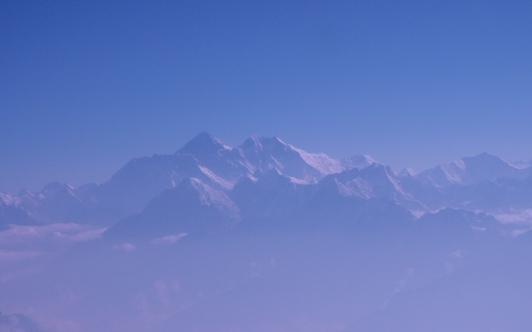
Mount Everest above the clouds
We still wanted to see the Himalayas, and we realized that air pollution would likely prevent that from ground level, so we went on a ‘mountain flight’. This flight (more than an hour late) was a small plane that took off from Kathmandu to the east. It climbed to 25,000 feet – just above the morning cloud level – and flew east along the southern edge of the Himalayas. From the port side of the plane, one could see the peaks above the clouds. We flew just past Everest and turned around. Those on the starboard side of the plane got the same view on the return. We were back on the ground within an hour. But as it turned out, this would be our only view of the Himalayas until we again flew out of Kathmandu heading home.
We had arranged a private guide and car to show us around the valley. We could not have negotiated getting around without him. We also would not have learned as much as we did. Although we spent more time than we had planned visiting temples, we learned why – there are more temples than houses and more god/goddess statues than people in Kathmandu Valley. Both Hindus and Buddhists celebrate their religions with great public flair.
We had previously learned that the temple architecture around the valley followed three basic styles: the Newari pagoda, the stupa, and the shikhara temple. The Newari pagoda – which may be Hindu, Buddhist, or both – is usually square and built on a stepped plinth. It has a tiered roof with one to five tiers. These are usually quite ornate. Stupas – which are Buddhist – are domed monuments built on a plinth. Atop the dome is a square harmika painted with eyes, atop the harmika is a spire, and atop the spire is a gilt parasol. The shikhara temple – which is Hindu – is also usually built on a stepped plinth. It is a tapering pyramidal tower surrounded by smaller towers. They may be simple or elaborate. We visited examples of each.
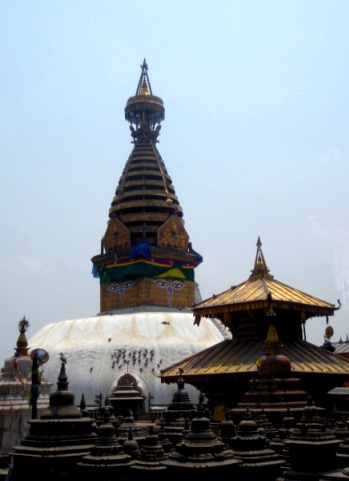
Swayambuth stupa
‘stupa’ style architecture
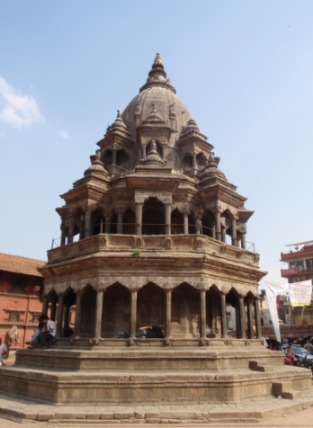
Krishna Temple in Patan Durbar Square ‘shikhara’ style architecture
We began our exploration at Kathmandu’s Durbar Square. Most of this square dates to the 17th and 18th century. The square is actually three loosely linked squares, and it is busy with activity including annoying touts and tour guides looking for work. We were particularly interested in the Kumari Bahal. The Kumari is a living child goddess, and she lives in a building in the square. She will be a goddess until she reaches puberty, and she then reverts to being a mere mortal. The Kumari is held in very high esteem.
After Kathmandu’s Durbar Square, we visited numerous sites outside the city but within the valley. We will describe those places in a counterclockwise manner starting in the west at Swayambhunath.
Swayambhunath – often called the Monkey Temple – is one of Kathmandu’s most recognized sites. This Buddhist temple was built in the 5th century, and it was an important Buddhist center by the 13th century. The stupa is a wealth of Buddhist symbolism including the Nepali ek symbol for unity, prayer wheels with the sacred mantra (om mani padme hum = hail to the jewel in the lotus), prayer flags, 13 concentric rings on the spire, etc. There are an interesting assortment of statues and two small 17th century shikharas. There is also a nice view of the city of Kathmandu from the stupa.
Just below Swayambhunath we visited the small village of Bagmati. This was a woodworking village, and we were impressed both by the friendliness of the people and the quality of work they were producing. We walked from Bagmati to Khohana which was a metalworking village. This village did not seem as warm or inviting as Bagmati, and we did not get much of a feel for it.
To the south we visited Patan which is the second largest town in the Kathmandu valley. Patan has a long Buddhist history, and the four corners of the town are marked by stupas believed to have been built around 250 BC by the Buddhist Emperor Ashoka. We visited Patan Durbar Square. This square runs north-south, and the palace occupies much of the eastern side. The western side is a beautiful display of both Buddhist bahals and Hindu temples. The Newari architecture is striking. Like Kathmandu’s Durbar Square, this square was most active during the 17th century during Malla rule.
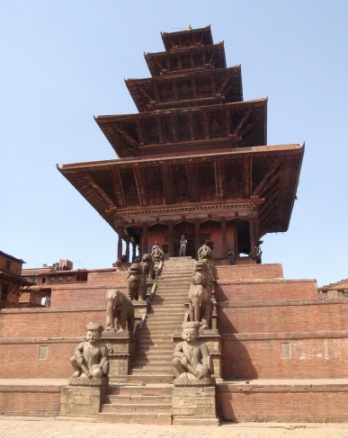
5-tiered Nyatapola Temple in Bhaktapur ‘pagoda’ style architecture
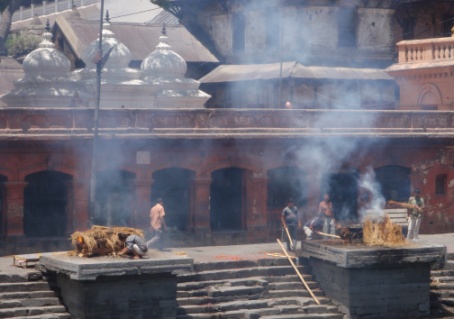
Cremations at Pashupatinath
We went a bit east to visit Bhaktapur which is the third major town in the valley. Bhaktapur is a traditionally intact town that still has cobblestone streets without vehicular traffic. To the unfamiliar, it appears to be a maze of temples, squares, monasteries, and shrines. We visited Bhaktapur Durbar Square, and it seemed less grand than the others. We also visited a thangka painting school where masters spend more than a decade learning to paint these traditional Tibetan works of art. We wandered through a pottery village where – no surprise – pottery was being made using traditional methods. We visited the Erotic Elephant Temple with carvings of, yes, erotic elephants. So, although we did not find Bhaktapur as ‘grand’ as Kathmandu or Patan, it offered a glimpse in to traditional life that the larger towns have mostly lost.
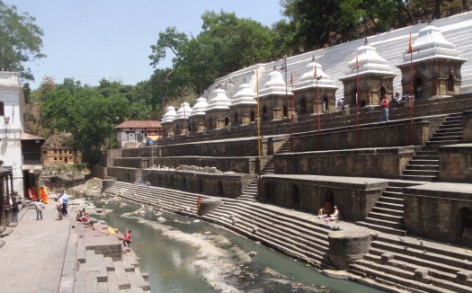
Chaityas (small temples) along Bagmati River
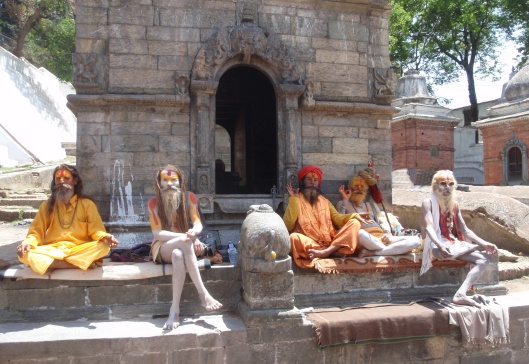
Sadhus at Pashupatinath
We also visited Bodnath a little further north. This is Nepal’s largest stupa, and it is one of the largest in the world. A particularly interesting aspect of Bodnath is that it is populated mostly by Tibetan Buddhists. Tibetan culture is alive and accessible here. The stupa was built sometime around the 7th century, and it has always been Tibetan. However, many of the Tibetans resident today arrived after a failed uprising against Chinese communists in 1959.
We had had enough of the frenetic pace in Kathmandu valley. We wanted some time in the mountains – even if we could likely not see them. We left the valley and headed east for a few days in the mountains.
Follow us to eastern Nepal.